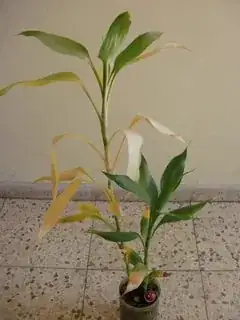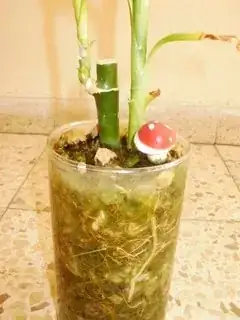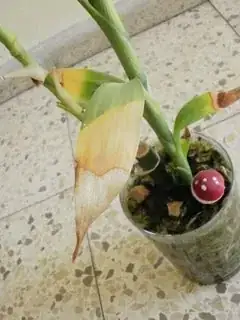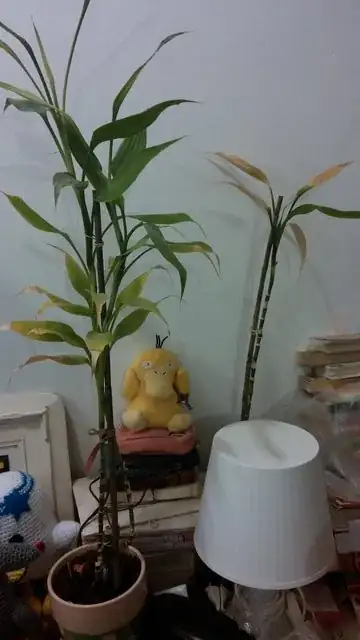Our lucky bamboo has turned yellow in a very short time, after we've had it for almost 2 years. We've trimmed all yellow leaves, and changed the pebble to clean the green algae - what else can be done? Why did this happen and what can we do to save it?
-
1We've trimmed all yellow leaves, and changed the pebble to clean the green algae - what else can be done? Please, [gardening.se], this plant is all we have! We don't have children, or even a dog. Help us! – Kobi Nov 26 '11 at 11:26
-
@Sue - It took me a while, but I've added an answer with a summary and an updated photo. Let me know if you need anything else. Thanks! – Kobi May 04 '16 at 05:05
-
I didn't see this mentioned, but Lucky Bamboo is not bamboo, it's a corn plant. That's so you can find helpful information on it. – Bulrush May 04 '16 at 13:04
6 Answers
It looks to me that your lucky bamboo is root bound. What that means is that the roots have outgrown the pot the plant is in and are getting suffocated. This reduces their ability to take in fertilizers and water, even if you're feeding them on schedule and can cause stunted growth and sometimes, yellowing.
In a plant potted in soil, you'd see something like the second picture in this answer. Your's looks a little different from that because of the pebbles, which are harder for the roots to push around. But the problem is the same.
I would suggest getting a larger pot and transplanting it so that the roots get some 'breathing space'. You might also want to propagate a couple of cuttings, as Mike Perry notes in this answer
Before transplanting into a larger pot, I would take a cutting or two from the plant (if it's viable, I can't tell from the photo as it doesn't show the top/whole of the plant) and propagate those cuttings, just in case something goes wrong during the transplant process.
- Here is a video on "How To Propagate Your Lucky Bamboo" that may prove helpful/useful.
- 11,099
- 7
- 55
- 92
-
1Interesting! The roots look like this, by the way: http://imgur.com/MgUEd , I guess it is pretty similar... But how can it be prevented? Won't they fill the whole pot either way? We've removed some of the roots that was covered in algae. Oh, and in the videos, it looks like all plants are in similarly sized pots. Now, a meta question: how can I accept an answer, if it can take weeks to see the results? – Kobi Nov 26 '11 at 17:56
-
Yeah, that looks pretty much like a rootbound plant would. It can't be prevented. You should get it a bigger pot so that it can grow freely. If you want to keep it in the same pot (so that the plant doesn't grow bigger than it is at the moment), then you should prune some of the excess roots to reduce the bulk. – Lorem Ipsum Nov 26 '11 at 18:06
-
3@Kobi Re: accepting an answer, you do not have to do it immediately. You can wait to try it out and accept it later if it helps. However, we do hope that you will return to update us of the status either by accepting or by editing your question to let us know what happened. Quite often, people do not come back to update us, but we greatly appreciate those of them that do as that helps validate answers and informs us if something didn't work as expected. – Lorem Ipsum Nov 26 '11 at 18:07
-
For the record - here's what we did: **1.** Removed the dead leaves and cut the dead parts off of other leaves. **2.** Changed the pebble, because it was covered with green goo. **3.** Pruned the roots, and cleaned green goo. It seems to be doing fine now. – Kobi Sep 20 '12 at 09:34
-
1
-
@Kobi Could you take a new picture of your plant and add your above comment as an edit to your question? It'll be helpful for future visitors – Lorem Ipsum Sep 20 '12 at 18:03
Here's what we eventually did to save the plant, mostly following the answers:
- Removed the dead leaves and cut the dead parts off of other leaves.
- Pruned the roots, and cleaned the green goo. This is pretty easy by washing the roots under a faucet.
- Changed the pebbles, because they were covered with green goo. We used potting soil instead of the pebbles it came in (I think they sell them with pebbles just because it looks nicer).
- Moved the plant to a bigger, opaque pot (I think a clear pot and sun exposure allowed the green goo to grow on the roots)
- Propagated a cutting. The next generation is not doing as well as the parent.
- Added plant stakes, because they both had trouble supporting themselves, and started having odd shapes.
We prune the roots and change the potting soil periodically. We forgot to do it for a while and the cutting was sad, but it's doing better now.
- 1,753
- 2
- 5
- 22
- 405
- 1
- 4
- 11
I've seen symptoms like this when the water has dropped too low (roots start to die and rot) and/or when the water has turned anoxic (no oxygen). Note that rotting roots when re-submerged will quickly turn the water anoxic.
I consider my answer and yoda's above to have a lot of overlap. We're both talking about a root problem and some variation of suffocation/anoxia.
One symptom of chemical anoxia is a sulfurous smell - and I have smelt this with lucky bamboo in an extreme case (stems had truly rotted!)
- 20,373
- 4
- 61
- 115
I had this happen to me once and eventually the yellowing went all the way down to the roots and the plant died. After doing some research, I was told it was a fungal disease. According to this FAQ, it looks like it could be a variety of things.
Edit 11/22/15: The original link provided above is no longer available, therefore I deleted it. Although I'm not sure it was the exact reference, here is a Frequently Asked Questions page about lucky bamboo care from the same site.
- 6,215
- 8
- 39
- 74
- 344
- 1
- 8
-
3Hello Kyle, welcome to [gardening.se]! Thanks for the answer; your link is quite informative. Could you please include the essential parts of the answer here (perhaps a summary in your own words), and provide the link for reference. This is done so that this answer is self-contained, and also to preserve the information if that link were to get taken down. Thanks :) – Lorem Ipsum Nov 30 '11 at 22:38
Mine was turning yellow until I stopped with tap water and started only giving it filtered or distilled water.
- 31
- 1
You need do change the water it is so dirty the bacteri and fungi is killing the bamboo. If you change the water weekly the bamboo will get healthier
- 21
- 1




